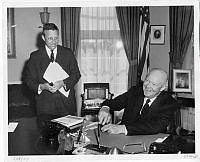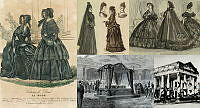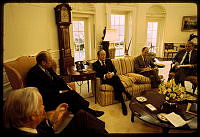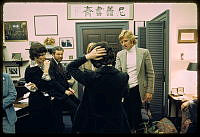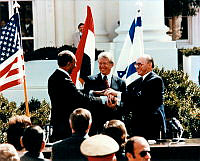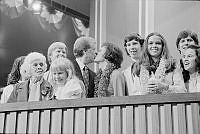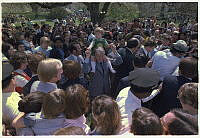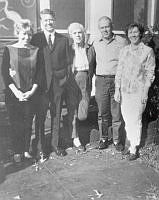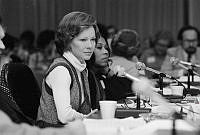James Madison

The oldest of twelve children, James Madison was born on March 16, 1751 to James and Nelly Madison. James Sr. was a slave owner and planter. In the early 1760s, he constructed a new home in Orange County, Virginia, and the family moved into the plantation estate, Montpelier.
Although James Madison was often ill as a child, he was also naturally inquisitive and studious. He pursued an education at the College of New Jersey, later known as Princeton University, and graduated in 1771. Madison returned to Virginia and was elected to the Virginia legislature in 1776, where he befriended Thomas Jefferson. When Jefferson was elected Governor of Virginia in 1779, Madison worked closely with him on the Governor’s Council. In 1780, Madison was called upon to represent Virginia in the Continental Congress, making him the youngest delegate at twenty-nine years old. In 1783, Madison returned to the Virginia state legislature, where he worked to pass the Virginia Statute of Religious Freedom in 1786, a document originally penned by Jefferson.
As the national government struggled to operate under the Articles of Confederation, Congress called for a Constitutional Convention in 1787. Ahead of the convention, Madison spent months in his library drafting a document now referred to as the Virginia Plan. The Virginia Plan laid the foundation for the United States Constitution, proposing a centralized government consisting of three branches, where each branch would provide checks and balances so that no branch could become too powerful. Over the next several months, Madison played a central role convincing the delegates to create a new government with more authority and centralized power rather than simply revising the Articles of Confederation.
After the delegates completed the Constitution, they submitted it to the states for ratification. As the state legislatures deliberated, Madison worked with Alexander Hamilton and John Jay to author a series of letters defending the Constitution. These letters, known as the Federalist Papers, were published in newspapers throughout the country. On June 21, 1788, New Hampshire became the ninth state to ratify the Constitution, securing enough votes to become the law of the land.
In 1789, Madison was elected to the U.S. House of Representatives, where he served four terms and fought to secure the passage of the Bill of Rights. In 1794, James Madison married a Quaker widow named Dolley Payne Todd. Three years later, he left Congress and returned to Montpelier with his wife. In February 1801, James Madison inherited the estate and over 100 enslaved individuals upon his father’s death. Click here to learn more about the enslaved households of President James Madison.
After the election of 1800, President Thomas Jefferson named Madison secretary of state. In this position, Madison supported the expansion of the United States with the Louisiana Purchase, opposed the seizure of American ships as Great Britain and France warred with one another, and backed the widely unpopular 1807 Embargo Act, which restricted trade with other nations.
In 1808, Madison was elected as the fourth President of the United States. He brought several enslaved individuals to the White House from Montpelier and hired out additional enslaved people to help run the presidential household. As White House hostess, First Lady Dolley Madison helped develop a social season in the fledgling capital city. Her Wednesday Drawing Rooms were lively occasions, and they brought together members of different political parties at the White House.
During his presidency, Madison faced mounting tensions between the United States and Great Britain. British forces continued to harass American ships, as well as seize cargo and impress American sailors into the Royal Navy. The “War Hawks” in Congress pressed Madison to consider military action. On June 18, 1812, the United States declared war on Great Britain.
The War of 1812 continued into Madison’s second term, as the underprepared United States attempted to defeat the British. On August 24, 1814, in retaliation for the American burning of York, the British entered Washington, D.C. and set fire to the White House, Capitol Building, the Treasury, and other government buildings. Four months later a peace agreement was brokered, and the war officially came to an end with the ratification of the Treaty of Ghent in February 1815.
After serving two terms, Madison retired to Montpelier in 1817. In his final years, Madison continued to rely upon enslaved labor to run his plantation. He also became an active member of the American Colonization Society, an organization that advocated for removing African Americans from the United States and sending them to a settlement colony in Africa. Madison served as the Society’s president for three years before he passed away at Montpelier in 1836. He is most remembered as the father of the U.S. Constitution.








